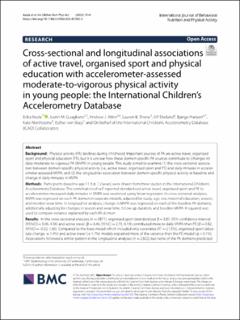Cross-sectional and longitudinal associations of active travel, organised sport and physical education with accelerometer-assessed moderate-to-vigorous physical activity in young people: the International Children’s Accelerometry Database
Ikeda, Erika; Guagliano, Justin M.; Atkin, Andrew J.; Sherar, Lauren B.; Ekelund, Ulf; Hansen, Bjørge Hermann; Northstone, Kate; van Sluijs, Esther
Peer reviewed, Journal article
Published version

View/
Date
2022Metadata
Show full item recordCollections
Original version
Ikeda, E., Guagliano, J. M., Atkin, A. J., Sherar, L. B., Ekelund, U., Hansen, B. H., Northstone, K. & van Sluijs, E. (2022). Cross-sectional and longitudinal associations of active travel, organised sport and physical education with accelerometer-assessed moderate-to-vigorous physical activity in young people: the International Children’s Accelerometry Database. International Journal of Behavioral Nutrition and Physical Activity, 19. https://doi.org/10.1186/s12966-022-01282-4Abstract
Background Physical activity (PA) declines during childhood. Important sources of PA are active travel, organised sport and physical education (PE), but it is unclear how these domain-specific PA sources contribute to (changes in) daily moderate-to-vigorous PA (MVPA) in young people. This study aimed to examine (1) the cross-sectional association between domain-specific physical activity (i.e., active travel, organised sport and PE) and daily minutes in accelerometer-assessed MVPA; and (2) the longitudinal association between domain-specific physical activity at baseline and change in daily minutes in MVPA. Methods Participants (baseline age 11.3 ± .1.2 years) were drawn from three studies in the International Children’s Accelerometry Database. The contribution of self-reported standardised active travel, organised sport and PE to accelerometer-measured daily minutes in MVPA was examined using linear regression. In cross-sectional analyses, MVPA was regressed on each PA domain in separate models, adjusted for study, age, sex, maternal education, season, and monitor wear time. In longitudinal analyses, change in MVPA was regressed on each of the baseline PA domains, additionally adjusting for changes in season and wear time, follow-up duration, and baseline MVPA. R-squared was used to compare variance explained by each PA domain. Results In the cross-sectional analyses (n = 3871), organised sport (standardised β = 3.81, 95% confidence interval [95%CI] = 3.06, 4.56) and active travel (β = 3.46, 95%CI = 2.73, 4.19) contributed more to daily MVPA than PE (β = 0.82, 95%CI = -0.02, 1.66). Compared to the base model which included only covariates (R2 = 21.5%), organised sport (absolute change: + 1.9%) and active travel (+ 1.7%) models explained more of the variance than the PE model (± < 0.1%). Associations followed a similar pattern in the longitudinal analyses (n = 2302), but none of the PA domains predicted change in MVPA (organised sport: standardised β = 0.85, 95%CI = -0.03, 1.72; active travel: β = 0.68, 95%CI = -0.14, 1.50; PE: β = 0.02, 95%CI = -0.87, 0.91). Conclusions A multi-sectoral approach covering a wide range of PA domains should be promoted to minimise the age-related decline in MVPA during childhood.
